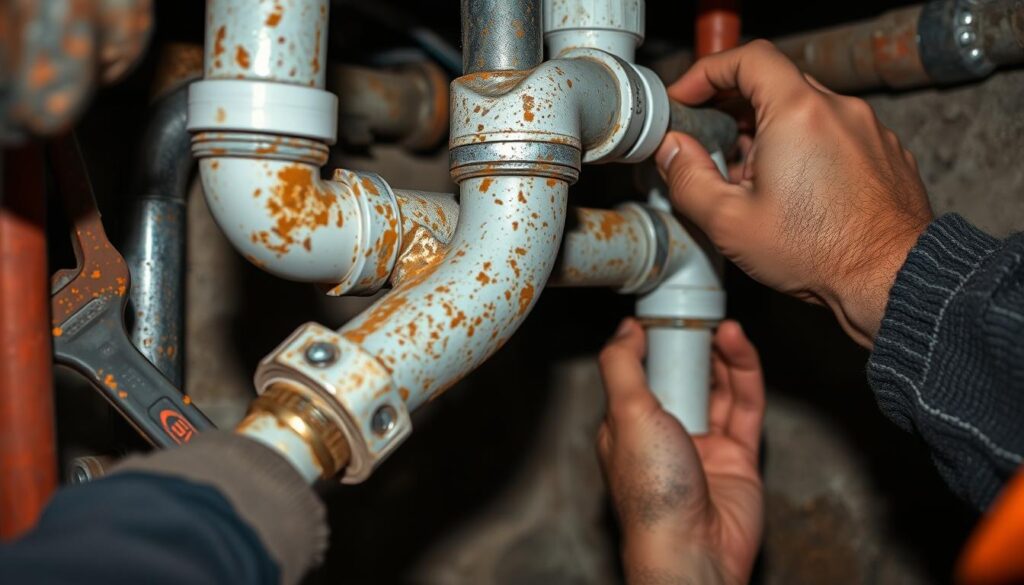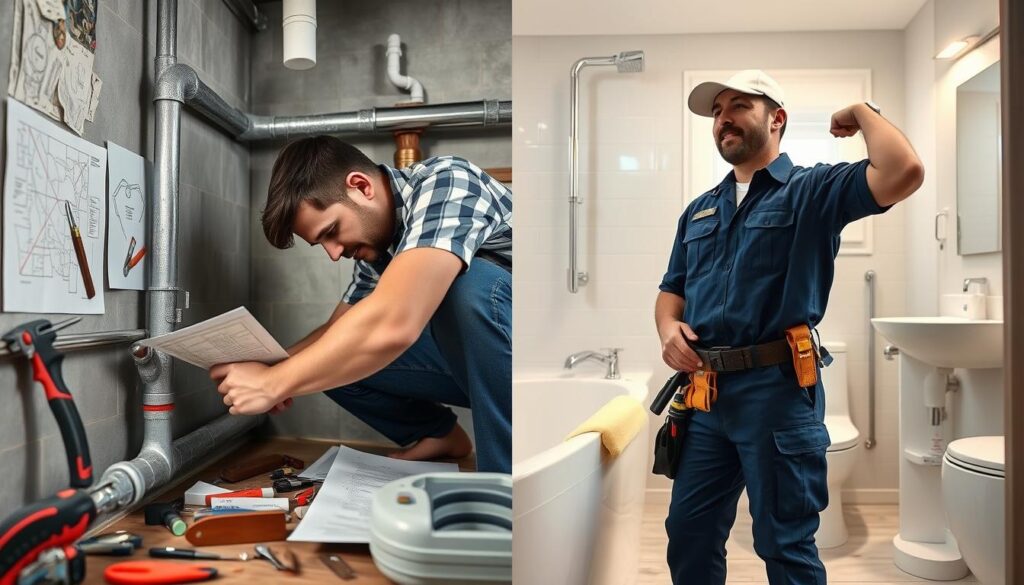Homeowners across the country are dealing with old plumbing systems. The cost to replace galvanized pipes is a big worry. This guide covers the costs, what affects them, and expert tips for your plumbing needs.

Key Takeaways
- Understand the lifespan and signs of deterioration in galvanized pipes.
- Explore the average costs for galvanized pipe replacement, including material and labor expenses.
- Discover the factors that can impact the overall cost, such as home size, pipe accessibility, and regional labor rates.
- Learn about the benefits of replacing old galvanized pipes and explore modern pipe material options.
- Decide whether a DIY or professional pipe replacement is the best choice for your home.
Understanding Galvanized Pipes and Their Lifespan
Galvanized pipes are made of zinc-coated steel and have been used in homes for many years. They protect against corrosion, making your plumbing last longer. Knowing how long they last and when they start to wear out is key to planning for replacements.
What Are Galvanized Pipes?
Galvanized pipes are coated with zinc to prevent rust. This makes them a strong choice for plumbing. They were common in homes built before the 1960s and are still found in many older homes.
Average Lifespan of Galvanized Plumbing
Galvanized pipes usually last between 20 to 50 years. But, their lifespan can change based on water quality, how often they’re used, and the plumbing’s condition.
Signs of Deteriorating Galvanized Pipes
As galvanized pipes get older, they show signs of wear. Look out for:
- Reduced water pressure or flow
- Discolored or rusty water
- Leaks or frequent pipe repairs
- Scaling or mineral buildup inside the pipes
If you see these signs, it might be time to replace your galvanized pipes. This will keep your plumbing system healthy and working well.
How Much Does It Cost to Replace Galvanized Pipes
Replacing galvanized pipes can cost a lot, depending on several things. Homeowners usually spend between $2,000 and $15,000 or more. This is what plumbers estimate.
The pipe replacement estimates depend on your home’s size and plumbing system complexity. Also, the type of new pipes matters. Bigger homes with more pipes cost more to replace.
| Home Size | Estimated Pipe Replacement Cost |
|---|---|
| 1,500 sq ft | $2,000 – $6,000 |
| 2,500 sq ft | $4,000 – $10,000 |
| 3,500 sq ft | $6,000 – $15,000 |
The cost breakdown for replacing galvanized pipes includes:
- Material costs for new pipes (copper, PEX, CPVC, etc.)
- Labor and installation fees
- Permits and inspections, if required
- Cleanup and disposal of old pipes
Remember, the actual pipe replacement estimates can change. This depends on your area and home’s specific needs. It’s wise to get quotes from different plumbers to find the best deal for your plumbing renovation budget.
Factors Affecting Galvanized Pipe Replacement Costs
When planning to replace aging galvanized pipes, homeowners must consider several key factors. These factors can significantly impact the overall cost of the plumbing project. Understanding these variables can help homeowners anticipate potential expenses and budget accordingly.
House Size and Pipe Accessibility
The size of the home and the accessibility of the existing plumbing system are crucial. Larger homes typically require more extensive pipe networks. This can lead to higher material and labor expenses.
Additionally, the ease of accessing the pipes can greatly affect the time and effort required. This, in turn, influences the labor costs.
Material Choices for Replacement
The choice of replacement pipe material is another significant factor in determining the project’s cost. Common options include copper, PEX (cross-linked polyethylene), and CPVC (chlorinated polyvinyl chloride). Each material has its own advantages and price points.
These prices can vary widely depending on regional availability and market conditions.
Labor Costs by Region
The geographic location of the home can also play a role in the overall replacement cost. Labor rates can differ substantially across different regions. Factors such as the cost of living, local regulations, and the availability of skilled plumbers all contribute to these variations.
| Plumbing Project Variables | Pipe Material Options | Regional Price Differences |
|---|---|---|
| House size and pipe accessibility | Copper, PEX, CPVC | Labor rates, cost of living, local regulations |
By considering these key factors, homeowners can better anticipate the financial implications. This ensures they make informed decisions and budget appropriately for the project.
Benefits of Replacing Old Galvanized Pipes
Switching from old galvanized pipes to new ones brings many benefits. You’ll get better water quality, a higher home value, and save on energy. These changes make your home better in many ways.
One big plus is the improved water quality. Old pipes can make water taste bad and look off-color. New pipes like copper, PEX, or CPVC keep your water clean and fresh.
Also, new plumbing can increase your home’s value. People want homes with modern plumbing because it means less upkeep and a longer life for the house.
Finally, new pipes are more energy efficient than old ones. They lose less heat, which can lower your bills and make your home greener.
| Benefit | Description |
|---|---|
| Improved Water Quality | Replacement of corroded galvanized pipes ensures clean, fresh-tasting water free from contaminants. |
| Increased Home Value | Updated plumbing systems are attractive to potential buyers, enhancing the overall property value. |
| Energy Efficiency | Modern pipe materials offer better insulation and reduced friction, leading to lower utility costs. |

Upgrading your plumbing can greatly improve your life and your home’s value. Replacing old pipes is a wise choice that benefits you for years.
Replacement Options and Modern Pipe Materials
Homeowners have many choices when replacing galvanized pipes. Options include copper, PEX, and CPVC. Each has its own benefits for different needs and budgets. Let’s dive into these options.
Copper Piping Solutions
Copper is a top pick for plumbing because it lasts long and resists corrosion. It can last 50 to 70 years with care. Copper is strong and handles high water pressure well. But, it might cost more to install than other choices.
PEX Piping Benefits
PEX, or cross-linked polyethylene, is becoming popular for its flexibility and affordability. It’s easy to install and resists corrosion and freezing. PEX can last 25 to 50 years, making it a good choice for many.
CPVC Alternatives
CPVC, or chlorinated polyvinyl chloride, is another modern option. It’s great at resisting chemicals and corrosion. Its installation is easier than copper’s. While not as flexible as PEX, CPVC works well in some situations.
“Choosing the right replacement material for your home’s plumbing is crucial to ensuring long-term performance and cost-effectiveness.”
DIY vs Professional Pipe Replacement
Homeowners often wonder if they should replace galvanized pipes themselves or hire plumbing contractors. DIY might seem cheaper, but it can lead to more problems. Hiring pros offers many benefits.
Replacing pipes is complex. It needs plumbing knowledge, building codes, and safety skills. DIYers might face water leaks, damage, or injury. Experts have the right tools and know-how for a smooth job.
- Proper pipe selection and sizing
- Adherence to local building codes and regulations
- Efficient and safe removal of old pipes
- Precise installation of new plumbing systems
- Thorough testing and inspection to prevent future issues
Professionals also offer warranties and guarantees. This means homeowners’ investments are safe. They use special tools and materials not available to DIYers.
| DIY Plumbing Risks | Professional Installation Benefits |
|---|---|
| Potential water leaks and structural damage | Adherence to building codes and regulations |
| Risk of personal injury | Warranties and guarantees on workmanship |
| Improper pipe selection and sizing | Access to specialized equipment and materials |
| Lack of expertise and licensing | Efficient and safe installation process |
Choosing between DIY and hiring plumbing contractors is important. DIY might seem appealing, but the risks are high. Hiring pros ensures a job well done, lasting for years.

Timeline and Process of Pipe Replacement
Replacing galvanized pipes is a big plumbing job that needs careful planning. Knowing the timeline and steps helps homeowners get ready. It makes the process smoother. Let’s look at the main steps to replace your old galvanized pipes.
Pre-Installation Planning
The first step is detailed pre-installation planning. You’ll talk to a professional plumber to check your pipes and pick the right materials. They’ll also measure and order what you need for a smooth install.
Installation Phases
The pipe replacement process has several steps. First, the plumber will turn off the water and drain the pipes. Then, they’ll remove the old pipes and get ready for the new ones. They’ll install the new pipes, making sure they’re sealed and connected right.
This might mean cutting through walls or floors. This needs extra care to avoid causing too much trouble.
Post-Installation Checks
After installing the new pipes, the plumber will check everything. They’ll test for leaks, check the water pressure, and make sure all fixtures work. They’ll also clean up and fix any damage.
The time it takes to replace galvanized pipes varies. It depends on your home’s size, plumbing complexity, and how easy it is to get to the pipes. A full-house replacement can take a few days to a week or more. Good communication with your plumber is key to a successful project.
“Replacing galvanized pipes is a critical home improvement project that can have a significant impact on the long-term health and functionality of your plumbing system.”
Conclusion
This guide has given homeowners a deep look into replacing galvanized pipes. It covered the costs, benefits, and choices involved. It helped readers understand the lifespan and signs of wear of these pipes.
It also explored different replacement materials and how they affect home improvement plans. This information helps homeowners make smart decision-making for their plumbing investment and home improvement planning.
Homeowners now know the risks of old galvanized pipes and the benefits of new ones. This knowledge helps them choose the best for their plumbing systems. It ensures their homes are safe, efficient, and valuable.
Whether you choose a professional or do it yourself, this guide has you covered. It gives the insights needed to replace galvanized pipes confidently. With this knowledge, you can start your home improvement journey with a clear plan and the right tools for success.
FAQ
What are the average costs to replace galvanized pipes?
The cost to replace galvanized pipes varies. It depends on the home’s size, how easy it is to get to the pipes, and the material used for replacement. On average, it can cost between $3,000 to $15,000 for a full plumbing system replacement.
What are the signs that galvanized pipes need to be replaced?
Signs that galvanized pipes need replacing include low water pressure and discolored water. You might also notice frequent leaks or clogs. The zinc coating can corrode over time, causing rust and weakening the pipes.
What are the benefits of replacing old galvanized pipes?
Replacing old pipes with modern ones has many benefits. You’ll get better water quality, a higher home value, and save on energy. New pipes last longer, so you won’t need to replace them as often.
What are the different pipe materials used to replace galvanized pipes?
You can choose from copper, PEX, or CPVC to replace galvanized pipes. Each has its own benefits. Copper is durable, PEX is flexible, and CPVC is cost-effective. The choice depends on your needs and budget.
Should I hire a professional or attempt a DIY galvanized pipe replacement?
While some can do it themselves, it’s best to hire a professional plumber. They have the skills to install pipes correctly and safely. This avoids leaks, damage, and code issues.
